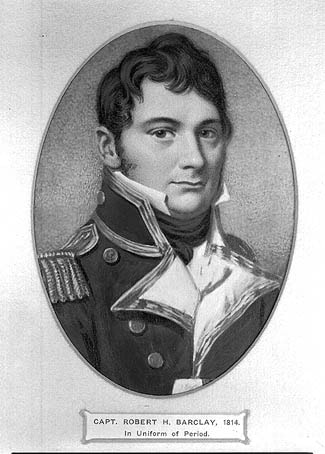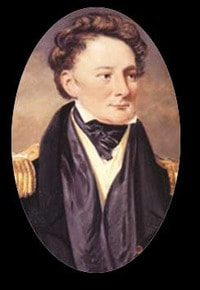|
By J. Grainger Robert Heriot Barclay (18 September 1786 – 8 May 1837) was born at Kettle, Scotland. He received a partial education in Kettle until around 1797 from John Strachan, who would later become an Anglican Bishop and politician, as well as a member of the powerful “Family Compact” in Upper Canada. Barclay entered the Royal Navy as a Midshipman in 1798, aged 11. In 1805 he was promoted Lieutenant, and took part in the Battle of Trafalgar aboard HMS Swiftsure. He was subsequently appointed second Lieutenant of the frigate HMS Diana, serving on blockade duty in the English Channel. In November 1809, he suffered wounds which led to the loss of his left arm while leading a boarding attack on a French convoy. After recovering, he was transferred to the North American Station, where he continued to serve as Lieutenant aboard several ships and smaller craft. After war with America broke out in 1812, the Commander in Chief on the North American station (Admiral Warren), detached Barclay and two other Lieutenants (Robert Finnis and Daniel Pring) to act as "Captains of Corvettes" on the Great Lakes. Barclay arrived at Kingston on Lake Ontario on May 5, 1813, and took charge of the existing Provincial Marine squadron there with the acting rank of Commander. Ten days later he was superseded by Captain James Lucas Yeo. Yeo first offered the command of the detached squadron on Lake Erie to his friend, Cmdr. William Mulcaster. Mulcaster declined the post, however, and it was subsequently offered to Barclay, who accepted. At the time, the Americans dominated Lake Ontario and held the Niagara Peninsula. As a result, Barclay was forced to travel overland to the Provincial Marine dockyard at Amherstburg, where his command was based, with a handful of officers and seamen. He arrived there on June 5. Although the Americans had no significant armed vessels on the lake, they were constructing two large brig-rigged corvettes at Presqu'Isle, and also transferring several smaller vessels from Black Rock on the Niagara River. Barclay immediately set sail in two of his own armed vessels. He first reconnoitered Presqu'Isle, and determined that it was defended by an entrenched force of 2000 militia with a well-placed artillery battery, and that the two new American brigs already had their lower masts fitted. He then attempted to intercept the American ships from Black Rock, but although at one point the two forces were apparently only fourteen miles apart, missed them in hazy weather. For the next few weeks, Barclay maintained a blockade of Presqu'Isle, preventing the Americans, under Master Commandant Oliver Hazard Perry, from crossing the sandbar at the mouth of the harbour. He meanwhile repeatedly requested that Yeo send him more sailors, ordinance, and supplies, and that the Lieutenant Governor of Upper Canada (Major General Francis de Rottenburg) reinforce the troops at Amherstburg under Major General Henry Procter. Neither senior officer sent the requested help. On July 28, bad weather and shortage of supplies forced Barclay to lift the blockade. When he returned three days later, Perry's force was free of the sandbar and apparently ready for action. Barclay reasoned that he was outnumbered and withdrew. From then on, the Americans controlled the lake, and the British were unable to move supplies to Amherstburg. Finally in September, Barclay had received a last reinforcement of a few officers and sailors and had mostly completed construction of a ship-rigged corvette (HMS Detroit), but very little food remained at Amherstburg. With no alternative options remaining, Barclay set out to fight Perry's squadron for control of the lake, and on September 10, 1813, in the resulting Battle of Lake Erie at Put-In Bay, Ohio, his squadron was defeated and captured. This was the first time in the history of the Royal Navy that an entire squadron was lost in a single battle. Barclay himself was severely wounded in his right arm and one of his legs, and taken as a prisoner of war. As was customary after any defeat or the loss of any ship, Barclay was required to face court-martial. Once freed by his American captors in 1814, he appeared before the court with one leg and his surviving arm still swathed in bandages. The court exonerated him, stating "the Judgement and Gallantry of Captain Barclay… were highly conspicuous and entitled him to the highest Praise”. His promotion to Commander was finally confirmed in November of that year. In August 1815, he married his first cousin, Agnes Cosser, at St John's Westminster (London), England, and they would go on to have several children. In November of the same year, he was granted an annual pension of £200 in consideration of his disability. Barclay later petitioned the Admiralty for further employment, but was granted only brief command of a bomb-vessel in 1822. From 1824 until his death in Edinburgh in 1837 at fifty years of age, he would see no further service.
0 Comments
|
G. Marshall & J. GraingerA series of articles relating to the history of the Provincial Marine and the naval aspects of the War of 1812 by two of Provincial Marine Amherstburg's most ardent researchers/writers. ArchivesCategories |



 RSS Feed
RSS Feed
